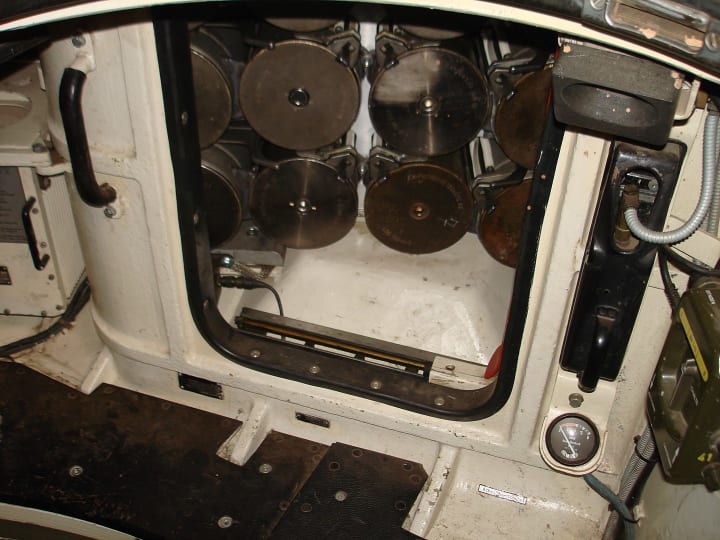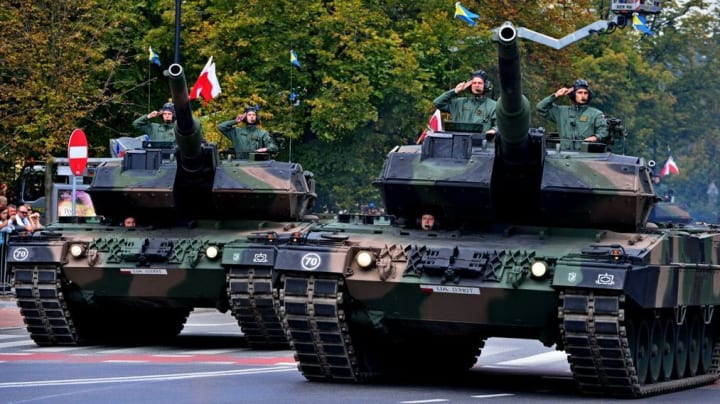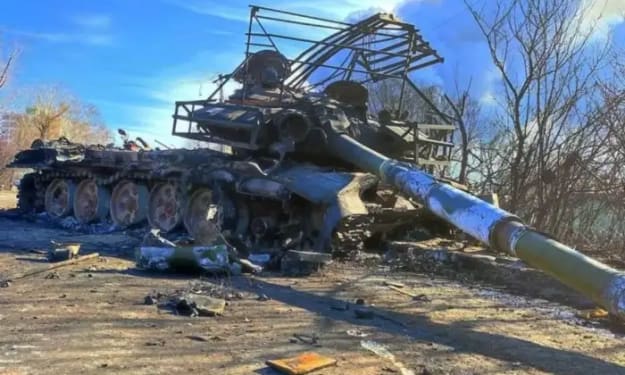Ukraine: Leopard Tanks on the Way?
We're hearing a lot about them, but what makes them special?

The news is that Poland is very close to sending German-built Leopard 2 main battle tanks ('MBT') to Ukraine. They require Germany's permission to do so, and there are signs that German resistance to the idea is weakening.
Germany has a fearsome reputation for building tanks. Their Panzers were the spearhead of Hitler's blitzkrieg (lightning war) attacks on his European neighbours.
The Nazi tank design peaked with the Tiger II. It was the largest tank mass-produced by German forces during the war (492 hulls), and remains among the heaviest mass-produced tanks ever at almost 70 tons. Its 88 mm KwK 43 could knock out virtually every Allied tank, while its sloped armour was thick enough to defeat most Allied guns. They proved to be unreliable in service, a surprising trait given the German reputation for high engineering quality.
But the design thread continued and the Leopard 2 is the current state of the art.
The requirement
Development of the Leopard 2 Main Battle Tank (MBT) began in 1970. It was just a couple of years after a previous Leopard 1 entered service. In those Cold War days a clash between NATO and the Warsaw Pact was possible and the West German army needed a well protected tank, which would be superior to the models introduced in the Eastern Block.
The Leopard 2 MBT (main battle tank) is produced by Krauss-Maffei Wegmann GmbH. It was designed as a replacement to the earlier Leopard 1 and went into service in 1979.
Design
The Leopard 2 was designed with an emphasis on mobility, firepower, protection, and ergonomics. The hull of the Leopard 2 is made out of welded steel with sloped armour plates that provide increased protection against enemy fire. The tank has seven roadwheels and uses a hydro-pneumatic suspension system that allows it to traverse difficult terrain while maintaining stability during firing.
Depending on specific model, they weigh in at between 62–65 tons.
Propulsion
The leopard 2 is powered by a liquid cooled MTU MB 873 Ka-501 turbodiesel engine that develops 1,500 horsepower. This makes it capable of reaching speeds of up to 70 km/h on smooth terrain and can cross trenches up to 2 m deep.
Gearboxes and transmission systems are always a problem for tanks and this is covered under 'Reliability'.
Armour
The USSR and Russian tank designs rely heavily on reactive armour, but Western designs use hi-tech steel/ceramic sandwich composites.
The Leopard 2 hull and turret uses composite armour plates made out of steel, aluminum, and ceramics to protect its crew from enemy fire, similar to the British Chobham sandwich armour.
I could find no information about protection from top-down attacks.
Arrowhead-shaped armour module of the Leopard 2A5:

Armament and active defence
The Leopard 2 is armed with a 120mm Rheinmetall L55 fully stabilised main gun that is capable of firing armour-piercing rounds at a range of 4,000 meters as well as a coaxial machine gun and smoke launching system. It also has an independent commander's machine gun with 360 degree rotation.
The tank also has an active protection system, which uses radar to detect incoming projectiles and then fires a countermeasure to intercept them before they can hit the tank. It can also detect incoming laser-guided weapons and react with countermeasures.
Fire control
Gun aiming is done through the Leopard 2's integrated fire-control system, which includes a laser rangefinder and ballistic computer. This allows the tank to accurately engage targets at long ranges, even in challenging conditions such as smoke or fog.
The Leopard 2 is equipped two periscopes for situational awareness, two sets of night vision goggles for the gunner and commander, an automatic target tracker, and an infrared searchlight. It also has emergency lighting systems that can be operated while driving in blackout conditions.
Ammunition
The Leopard uses the following types of ammunition:
- high-explosive anti-tank (HEAT), armour-piercing fin-stabilized discarding sabot (APFSDS)
- the latest high explosive squash head (HESH). A high-explosive squash head is a type of explosive projectile with plastic explosive that conforms to the surface of a target before detonating, which improves the transfer of explosive energy to the target
- anti-tank guided missiles
- smoke grenade launchers on either side of the turret, allowing it to quickly deploy a thick smokescreen for cover

The tank carries 42 rounds for the main gun: A total of 15 ready-to-use rounds are stored in the turret bustle, while the rest are store in front of the hull by the driver.
Range
The Leopard 2 has a range of 600 kilometers on roads and 400 kilometers off-road, allowing it to cover large distances without refueling. It also has an onboard water supply that allows it to travel across bodies of water such as rivers and lakes.
This system allows the tank to carry a large amount of water for use in various situations, such as for the crew to drink or to use for fire suppression in the event of a fire. The water is stored in tanks located within the tank and can be easily accessed by the crew through a system of pumps and valves. The tank also has a filtration system that can purify water taken from outside sources, allowing the crew to use it if necessary.
Finally, the Leopard battle tank is equipped with its own air filtration system to provide clean air for the crew in case of chemical or biological warfare agents. This allows operation in contaminated areas for longer periods of time without risking contamination of the crew.
Speed
The Leopard 2 is a highly mobile tank, designed to engage in both defensive and offensive operations. The V-12 diesel engine gives it a top speed of around 72 km/h (45 mph) on road and a range of around 550 km (340 miles). Additionally, the Leopard 2 has a very low ground pressure, which allows it to operate in a wide range of terrains, including snow, mud, and sand.
Other features
The Leopard-2 has a crew of four, including commander, gunner, loader and driver. One interesting feature about this main battle tank, that it has an escape hatch in the floor behind the driver.
The Leopard 2 can be fitted with a deep wading kit. After preparation it can ford water obstacles up to 4 m deep.

Reliability
This is a key issue for tanks, which require a huge logistical back-up system with heavy recovery vehicles to retrieve them.
Designing for quick and easy maintenance is an important consideration.
I remember an old pal (RIP Peter) who was a tank driver in the BAOR (British Army of the Rhine) and used to curse the work involved in changing a Chieftain tank engine in the field. 'Thirty two fucking bolts had to be undone from underneath the engine compartment, in snow or mud. It was bastard of a job'.
One area in which the Leopard 2 has been known to have problems is with its engine. The V-12 diesel engine can be prone to overheating and breakdowns if not properly maintained. In addition, the engine's emissions control system can also cause problems, particularly in cold temperatures.

Another area in which the Leopard 2 has been known to have problems is with its transmission. The tank's transmission is a complex system. Some of the issues that have been reported with the transmission include slipping gears, difficulty shifting gears, and difficulty engaging reverse.
A third area of concern for the Leopard 2 is its track system. The tank's tracks are subject to a lot of wear and tear due to their constant use, and can become damaged if not properly maintained. In addition, the Leopard 2's tracks are known to be particularly susceptible to damage from mines and improvised explosive devices (IEDs).
The problems mentioned above with the engine, transmission, and track systems are not unique to the Leopard 2, but are common issues with many tanks. With proper maintenance, the Leopard 2's engine, transmission, and track systems are generally reliable and breakdowns are relatively rare.
The issue of high mobility and speed causing track problems led to the concept of the wheeled tank.
Production and sales
The total built to date is 3,600 units and it is still in production.
By 1993 German army operated a total of 2,155 of these MBTs. The Leopard 2 was also a commercial success and was exported worldwide. Export operators were Netherlands (445 tanks), Switzerland (380 tanks), Sweden (282), Spain, Turkey (354), and some other countries. A number of Leopard 2 tanks were sold to other countries from German and Dutch surplus stocks. By 2019 a total of 16 countries were using this tank. (Military Today)
Over the years, several variants of the Leopard 2 have been developed, including the Leopard 2A4, 2A5, 2A6, and 2A7. Each variant has its own specific features and capabilities, but all share the same basic design and performance characteristics.
Deployment
The Leopard 2 has been used in a number of conflicts and peacekeeping operations, including the Gulf War, the Balkans, and Afghanistan. It has proven to be a reliable and effective tank, with a very low loss rate in combat.
What makes them special?
I think it's the all round combination of features which have evolved through continuous improvement and good engineering.
And Polish Leopards in Ukraine? We'll soon find out.

***
About the Creator
James Marinero
I live on a boat and write as I sail slowly around the world. Follow me for a varied story diet: true stories, humor, tech, AI, travel, geopolitics and more. I also write techno thrillers, with six to my name. More of my stories on Medium






Comments
There are no comments for this story
Be the first to respond and start the conversation.